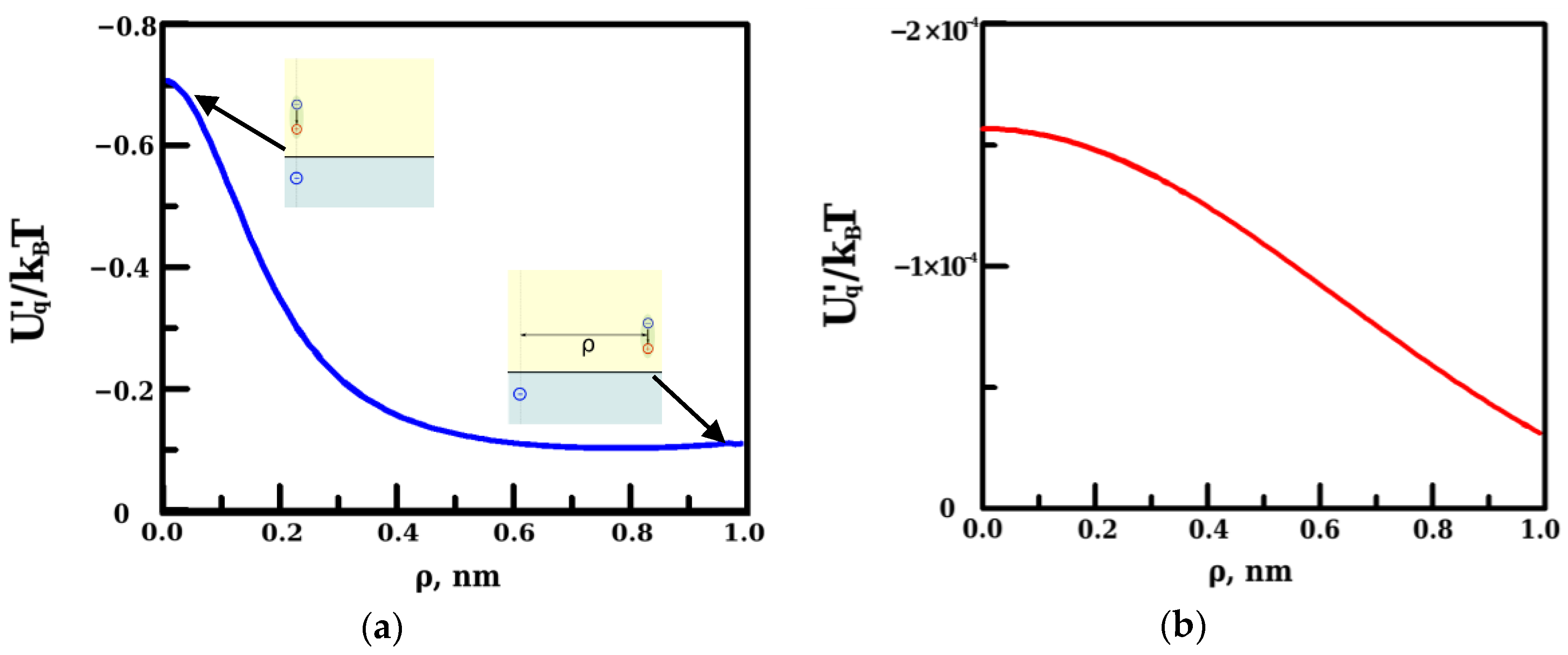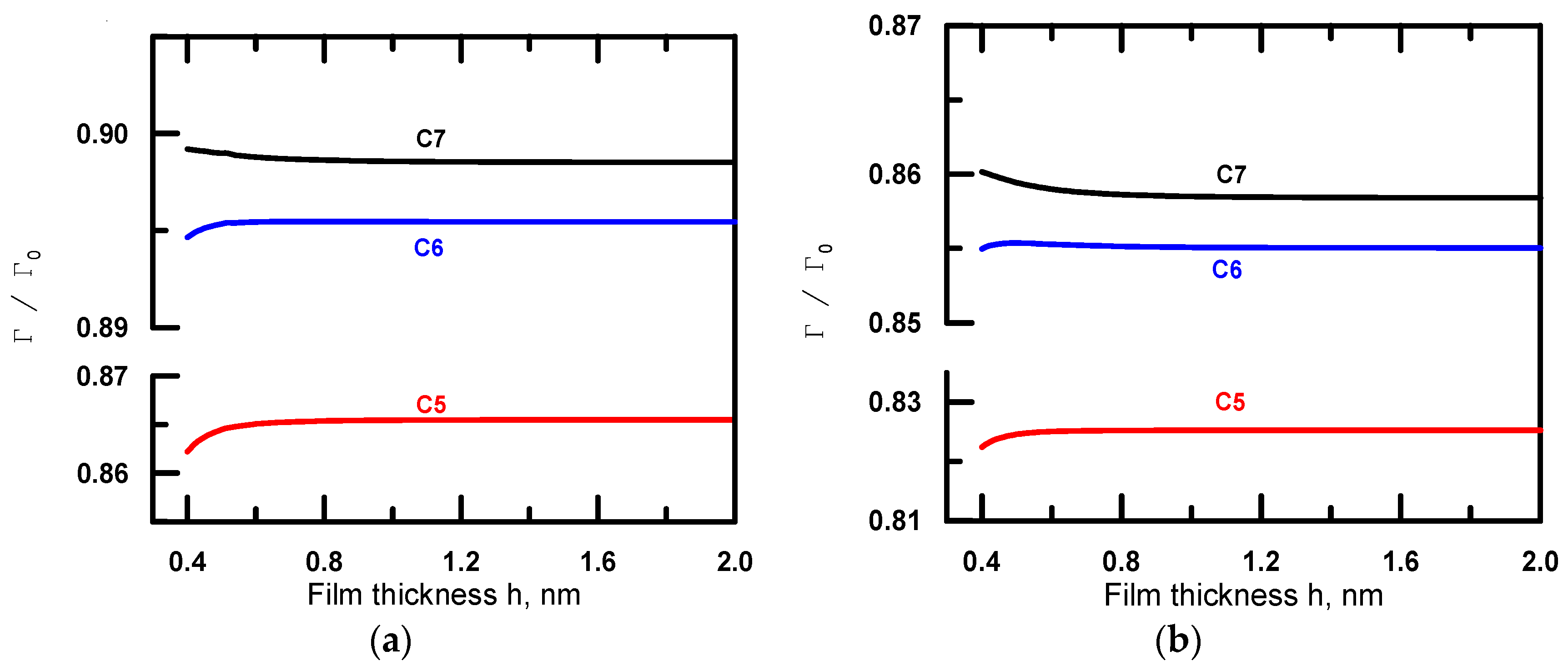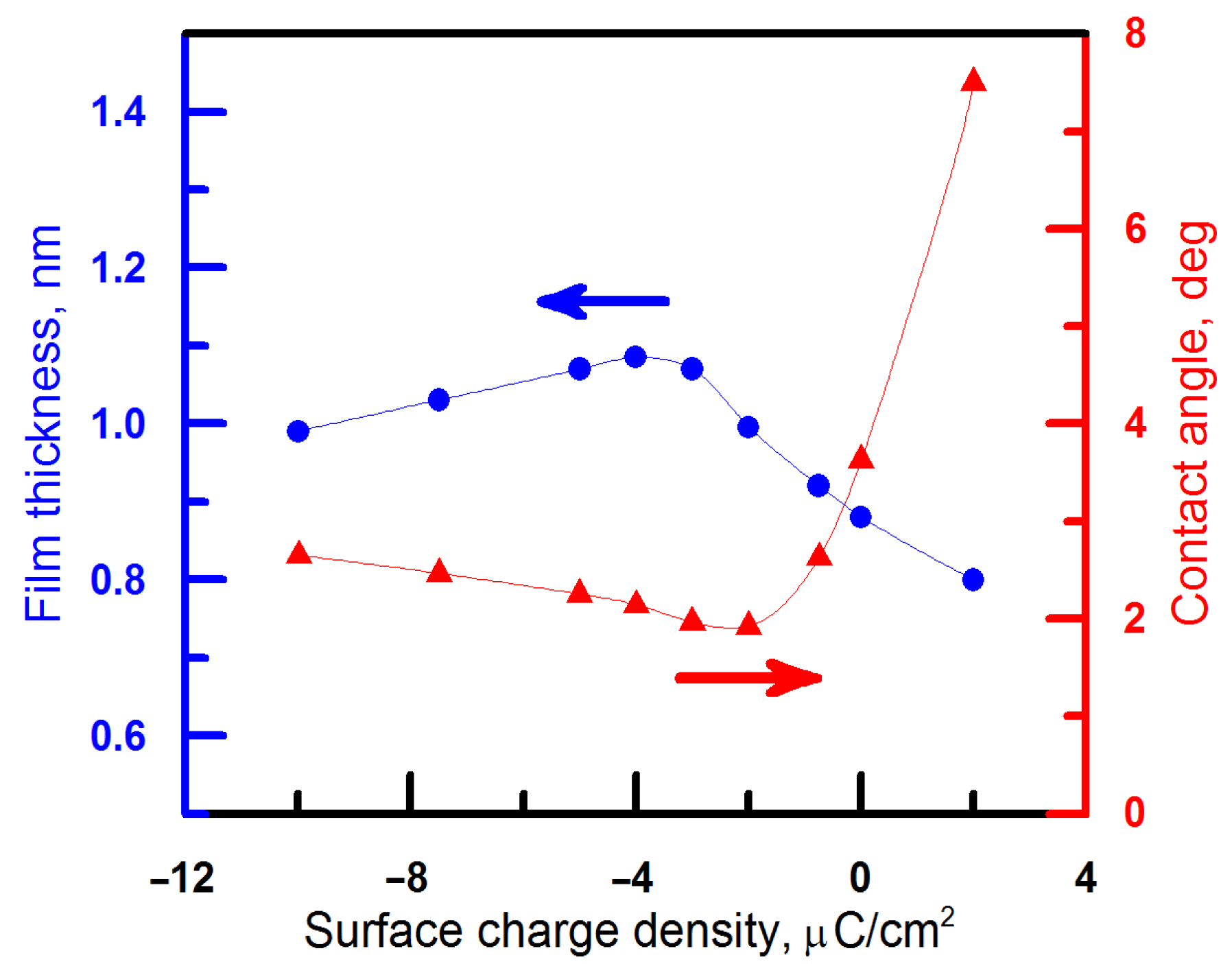Image Charge Effects in the Wetting Behavior of Alkanes on Water with Accounting for Water Solubility
Abstract
:1. Introduction
2. Excess Energy of Alkane Film Associated with Water Solubility in Alkane
2.1. Electrostatic Potential in Alkane Film Induced by a Discretely Charged Interface, with Charges, Located in the Electrolyte Phase Close to the Interface
2.2. Image-Charge Contribution to the Excess Adsorption of Solute Water Molecules and to the Excess Free Energy of Alkane Wetting Films on Water
3. Image-Charge Contribution to the Disjoining Pressure in Alkane Wetting Films on Water and its Influence on the Wettability
4. Concluding Remarks
Acknowledgments
Author Contributions
Conflicts of Interest
References
- Yamamoto, D.; Nakajima, C.; Shioi, A.; Krafft, M.P.; Yoshikawa, K. The evolution of spatial ordering of oil drops fast spreading on a water surface. Nat. Commun. 2015, 6, 7189. [Google Scholar] [CrossRef] [PubMed]
- Boinovich, L.; Emelyanenko, A. Wetting behaviour and wetting transitions of alkanes on aqueous surfaces. Adv. Colloid Interface Sci. 2009, 147–148, 44–45. [Google Scholar] [CrossRef] [PubMed]
- Emelyanenko, K.A.; Emelyanenko, A.M.; Boinovich, L. Image-charge forces in thin interlayers due to surface charges in electrolyte. Phys. Rev. E 2015, 91, 032402. [Google Scholar] [CrossRef] [PubMed]
- Boinovich, L.; Emelyanenko, A. Wetting Behavior of Pentane on Water. The Analysis of Temperature Dependence. J. Phys. Chem. B 2007, 111, 10217–10223. [Google Scholar] [CrossRef] [PubMed]
- Hauxwell, F.; Ottewill, R.H. A study of the surface of water by hydrocarbon adsorption. J. Colloid Interface Sci. 1970, 34, 473–479. [Google Scholar] [CrossRef]
- Del Cerro, C.; Jameson, G.J. The behavior of pentane, hexane, and heptane on water. J. Colloid Interface Sci. 1980, 78, 362–375. [Google Scholar] [CrossRef]
- Ragil, K.; Meunier, J.; Broseta, D.; Indekeu, J.O.; Bonn, D. Experimental Observation of Critical Wetting. Phys. Rev. Lett. 1996, 77, 1532–1535. [Google Scholar] [CrossRef] [PubMed]
- Pfohl, T.; Riegler, H. Critical Wetting of a Liquid/Vapor Interface by Octane. Phys. Rev. Lett. 1999, 82, 783–786. [Google Scholar] [CrossRef]
- Bonn, D.; Bertrand, E.; Shahidzadeh, N.; Ragil, K.; Dobbs, H.T.; Posazhennikova, A.I.; Broseta, D.; Meunier, J.; Indekeu, J.O. Complex wetting phenomena in liquid mixtures: Frustrated-complete wetting and competing intermolecular forces. J. Phys. Condens. Matter 2001, 13, 4903–4914. [Google Scholar] [CrossRef]
- Brochard-Wyart, F.; di Meglio, J.-M.; Quere, D.; de Gennes, P.-G. Spreading of Nonvolatile Liquids in a Continuum Picture. Langmuir 1991, 7, 335–338. [Google Scholar] [CrossRef]
- Beattie, J.K.; Djerdjev, A.M.; Warr, G.G. The surface of neat water is basic. Faraday Discuss. 2009, 141, 31–39. [Google Scholar] [CrossRef] [PubMed]
- Feick, J.D.; Velegol, D. Measurements of Charge Nonuniformity on Polystyrene Latex Particles. Langmuir 2002, 18, 3454–3458. [Google Scholar] [CrossRef]
- Faraudo, J.; Travesset, A. The Many Origins of Charge Inversion in Electrolyte Solutions: Effects of Discrete Interfacial Charges. J. Phys. Chem. C 2007, 111, 987–994. [Google Scholar] [CrossRef]
- Gan, Z.; Xing, X.; Xu, Z. Effects of image charges, interfacial charge discreteness, and surface roughness on the zeta potential of spherical electric double layer. J. Chem. Phys. 2012, 137, 034708. [Google Scholar] [CrossRef] [PubMed]
- Xu, Z. Electrostatic interaction in the presence of dielectric interfaces and polarization-induced like-charge attraction. Phys. Rev. E 2013, 87, 013307. [Google Scholar] [CrossRef] [PubMed]
- Wang, H.; Singh, V.; Behrens, S.H. Image Charge Effects on the Formation of Pickering Emulsions. J. Phys. Chem. Lett. 2012, 3, 2986–2990. [Google Scholar] [CrossRef] [PubMed]
- Boneva, M.P.; Danov, K.D.; Christov, N.C.; Kralchevsky, P.A. Attraction between Particles at a Liquid Interface Due to the Interplay of Gravity- and Electric-Field-Induced Interfacial Deformations. Langmuir 2009, 25, 9129–9139. [Google Scholar] [CrossRef] [PubMed]
- Boinovich, L.B.; Emelyanenko, A.M. The image-charge forces in thin films of solutions with non-polar solvent. Adv. Colloid Interface Sci. 2003, 104, 93–121. [Google Scholar] [CrossRef]
- Joensson, B.; Attard, P.; Mitchell, D.J. Interaction between dipolar surfaces in a dielectric continuum model. J. Phys. Chem. 1988, 92, 5001–5005. [Google Scholar] [CrossRef]
- Attard, P.; Mitchell, D.J. The forces between surfaces of mobile, orientable dipoles. The method of reflection coefficients. J. Chem. Phys. 1988, 88, 4391–4396. [Google Scholar] [CrossRef]
- Martynov, G.A.; Smilga, V.P. Interaction of colloids with adsorbed dipole molecules. Colloid J. 1965, 27, 250–253. [Google Scholar]
- Schatzberg, P. Solubilities of water in several normal alkanes from C7 to C16. J. Phys. Chem. 1963, 67, 776–779. [Google Scholar] [CrossRef]
- Englin, B.A.; Plate, A.F.; Tugolukov, V.M.; Pryanishnikova, M.A. Solubility of water in individual hydrocarbons. Chem. Technol. Fuels Oils 1965, 1, 722–726. [Google Scholar] [CrossRef]
- Polak, J.; Lu, B.C.Y. Mutual Solubilities of Hydrocarbons and Water at 0 and 25 °C. Can. J. Chem. 1973, 51, 4018–4023. [Google Scholar] [CrossRef]
- Tsonopoulos, C.; Wilson, G.M. High-temperature mutual solubilities of hydrocarbons and water. Part I: Benzene, cyclohexane and n-hexane. AIChE J. 1983, 29, 990–999. [Google Scholar] [CrossRef]
- Briscoe, W.H.; Horn, R.G. Direct measurement of surface forces due to charging of solids immersed in a nonpolar liquid. Langmuir 2002, 18, 3945–3956. [Google Scholar] [CrossRef]
- Blake, T.D.; Cayias, J.L.; Wade, W.H.; Zerdecki, J.A. Adsorption on flat surfaces. II. Low-energy surfaces. J. Colloid Interface Sci. 1971, 37, 678–685. [Google Scholar] [CrossRef]
- Kusakov, M.; Titievskaya, A. Properties of the polymolecular layers of nonionic liquids. Dokl. Chem. 1940, 28, 333–336. [Google Scholar]
- Boinovich, L.B.; Derjaguin, B.V. Investigation of the isotherms of the disjoining pressure of wetting films of binary nonionic solutions by the ellipsometric method. Colloids Surf. 1988, 34, 43–54. [Google Scholar] [CrossRef]
- Grigoriev, N.V.; Krylov, V.S. Discrete structure of double electric layer at chemisorption of dipole molecules. Russ. J. Electrochem. 1968, 4, 763–769. [Google Scholar]
- Levine, S.; Bell, G.M.; Calvert, D. The discreteness-of-charge effect in electric double layer theory. Can. J. Chem. 1962, 40, 518–538. [Google Scholar] [CrossRef]
- Boinovich, L.B.; Emelyanenko, A.M. On the effect of discrete charges adsorbed at the interface on the nonionic liquid film stability: charges in the film. J. Phys. Condens. Matter 2008, 20, 494227. [Google Scholar] [CrossRef]
- Boinovich, L. DLVO forces in thin liquid films beyond the conventional DLVO theory. Curr. Opin. Colloid Interface Sci. 2010, 15, 297–302. [Google Scholar] [CrossRef]
- Chowdhary, J.; Ladanyi, B.M. Water-hydrocarbon interfaces: Effect of hydrocarbon branching on interfacial structure. J. Phys. Chem. B 2006, 110, 15442–15453. [Google Scholar] [CrossRef] [PubMed]
- Derjaguin, B.V.; Dzyaloshinsky, I.E.; Koptelova, M.M.; Pitaevsky, L.P. Molecular-surface forces in binary solutions. Faraday Discuss. 1965, 40, 246–252. [Google Scholar] [CrossRef]
- Calo, A.; Domingo, N.; Santos, S.; Verdaguer, A. Revealing Water Films Structure from Force Reconstruction in Dynamic AFM. J. Phys. Chem. C 2015, 119, 8258–8265. [Google Scholar] [CrossRef]
- Boinovich, L.B.; Emelyanenko, A.M. Alkane films on water: Stability and wetting transitions. Russ. Chem. Bull. 2008, 57, 263–273. [Google Scholar] [CrossRef]
- Derjaguin, B.V.; Churaev, N.V.; Muller, V.M. Surface Forces; Consultants Bureau: New York, NY, USA, 1987. [Google Scholar]





| System | ρ, nm | UOH/kBT | Udisp/kBT | Uimn/kBT | UimP/kBT | Ulat/kBT | Uq/kBT |
|---|---|---|---|---|---|---|---|
| water/pentane/air | 0.0 | −8.6 | −0.88 | −1.84 | −1.54 | 3.70 | −0.70 |
| 1.0 | −8.6 | −0.88 | −1.84 | −1.54 | 3.45 | −0.10 | |
| water/hexane/air | 0.0 | −8.6 | −0.92 | −1.80 | −1.51 | 3.78 | −0.70 |
| 1.0 | −8.6 | −0.92 | −1.80 | −1.51 | 3.56 | −0.11 |
| Alkane | for σ = 0 | for σ = –5 μC·cm−2 | ||||||
|---|---|---|---|---|---|---|---|---|
| ρ = 0 | ρ = 0.5 nm | ρ = 1 nm | ||||||
| h0, nm | θ, ° | h0, nm | θ, ° | h0, nm | θ, ° | h0, nm | θ, ° | |
| Pentane | 0.88 | 3.6 | 1.30 | 2.0 | 1.2 | 2.1 | 0.88 | 2.9 |
| Hexane | 0.47 | 12.1 | 0.56 | 8.1 | 0.48 | 10.2 | 0.46 | 12.3 |
| Heptane | 0.37 | 16.9 | 0.37 | 17.2 | 0.36 | 19.4 | 0.35 | 22.3 |
© 2016 by the authors; licensee MDPI, Basel, Switzerland. This article is an open access article distributed under the terms and conditions of the Creative Commons by Attribution (CC-BY) license (http://creativecommons.org/licenses/by/4.0/).
Share and Cite
Emelyanenko, K.A.; Emelyanenko, A.M.; Boinovich, L.B. Image Charge Effects in the Wetting Behavior of Alkanes on Water with Accounting for Water Solubility. Materials 2016, 9, 177. https://doi.org/10.3390/ma9030177
Emelyanenko KA, Emelyanenko AM, Boinovich LB. Image Charge Effects in the Wetting Behavior of Alkanes on Water with Accounting for Water Solubility. Materials. 2016; 9(3):177. https://doi.org/10.3390/ma9030177
Chicago/Turabian StyleEmelyanenko, Kirill A., Alexandre M. Emelyanenko, and Ludmila B. Boinovich. 2016. "Image Charge Effects in the Wetting Behavior of Alkanes on Water with Accounting for Water Solubility" Materials 9, no. 3: 177. https://doi.org/10.3390/ma9030177






